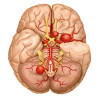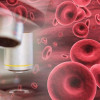
 Mr. Swapnil Bhowmick
Mr. Swapnil Bhowmick
Aplastic anemia - Symptoms and causes - Medtalks
Aplastic Anemia
Aplastic anemia, also known as idiopathic aplastic anemia, is a kind of anemia in which the bone marrow ceases producing new blood cells. This might result in serious health issues. It is an example of normoblast normochromic anemia.
The Pathophysiology of Aplastic Anemia
Anemia is a condition in which a person's red blood cells (RBCs) are insufficiently functional. The oxygen-carrying RBCs are in charge of transport. Your body can not carry oxygen properly when you are anemic, which can make you fatigued and weak. The protein hemoglobin is used by RBCs to transport oxygen. For effective oxygen transfer, hemoglobin is required. It binds oxygen strongly in high-oxygen environments before releasing it in low-oxygen environments. Your blood is also reddened by hemoglobin. Iron is found in hemoglobin and is required for it to bind oxygen. Iron deficiency causes a lot of anemia instances. Aplastic anemia, on the other hand, is caused by a bone marrow issue rather than an iron shortage. The ailment is uncommon, but if left untreated, it can be deadly. Consult your doctor straight away if you are experiencing signs of aplastic anemia.
Symptoms of Aplastic Anemia
Aplastic anemia has symptoms that are similar to those of typical anemia. When your RBC count is low, you may experience the following symptoms:
Excessive fatigueness
Dizziness
Cold-temperature sensitivity
Weakness
Tachycardia
Irritability
Paleness
Breathing problems
Low platelet counts can lead to the following complications:
Nose bleed
Bleeding gums
Easy skin bruises
Rash with minute pinpoints
Susceptibility to infections, if the levels of WBCs goes down.
Causes of Aplastic Anemia
Damage to the bone marrow causes aplastic anemia.
Blood cells are generally produced by stem cells in the marrow, which include:
Platelets
Red blood cells (RBCs)
White blood cells (WBCs)
In persons with aplastic anemia, this mechanism is interrupted. The stem cells have been destroyed, and there aren't enough blood cells being produced.Your bone marrow can be damaged by a variety of factors. The source of damage in persons with idiopathic aplastic anemia is generally unclear, although various variables have been associated to it.
Aplastic anemia is thought to be an autoimmune disease by some experts. As with an infection, the body assaults its own cells in autoimmune illnesses. Other factors to consider are:
Adverse response to certain medications for arthritis
Epilepsy
Illness
Harmful chemicals used in industry or agriculture, such as benzene, solvents, or glue fumes
Exposure to radiation or chemotherapy, in case of cancer treatment.
Anorexia nervosa is a severe eating disorder linked to aplastic anemia, as well as viruses such as Epstein-Barr, HIV, and various herpes viruses. Aplastic anemia can be inherited, albeit this is extremely unusual. Iron deficiency does not produce aplastic anemia.
Diagnosis of Aplastic Anemia
A blood test is used to identify all kinds of anemia. If you have low amounts of RBCs, WBCs, or platelets, a complete blood count (CBC) will reveal it. It's critical to establish the reason for anemia after it's been identified. A bone marrow biopsy may be required if your doctor suspects aplastic anemia. To collect the marrow, a needle will be put into your hip bone. The number of stem cells present in the sample will be determined.
Your idiopathic aplastic anemia will be classified as acute or chronic by your doctor. Acute instances appear out of nowhere and can be extremely severe. Chronic instances take longer to develop. They are, however, equally as difficult to treat.
Treatment of Aplastic Anemia
Your treatment will be determined by the severity of your disease. Some types of aplastic anemia are so mild that they don't require therapy. It may be necessary to stop using a prescription or avoid exposure to potentially harmful substances. Transfusions of blood and platelets are required in many mild cases. Acute instances almost always need transfusions. Bone marrow transplants are a treatment option for severely affected patients. Your stem cells are replaced with those from a donor in this procedure. People under the age of 40 who have sibling donors benefit the most from the therapy.
The Bottom Line
Idiopathic aplastic anemia, both severe and acute, can be deadly. The importance of proper therapy cannot be overstated. Younger persons have the highest survival rates because they are more likely to react to therapy.
The following are examples of possible treatment complications:
Infections caused by adverse medication responses
Failure of a bone marrow transplant
Excessive hemorrhage
Reference:

Mr. Swapnil Bhowmick
A motivated student of Medicine & Surgery (MBBS) at R. G. Kar Medical College & Hospital, Kolkata, having a knack for reading and composing medical literature. When he's not writing content for MEDtalks, Swapnil is usually looking up the latest trends and innovations in Medicine.











Please login to comment on this article